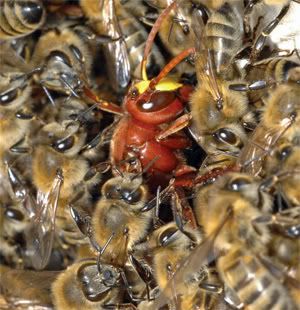Collective defense of honey bee nests show grisly adaptations in action

Honeybees cooperate in the asphyxiation of a trespassing wasp
Cyprian honey bees under attack by predator hornets have evolved a grisly and lethal way of fighting back which scientists have called "asphyxia-balling."
An intruding hornet looking for a snack in a beehive may suddenly find itself enveloped inside a buzzing ball of black-and-yellow worker drones. The bees squeeze in tightly around the abdomen – where hornets breath – until the would be aggressor dies of suffocation.
A team of Greek and French biologists, led by Alexandrous Papachristoforou of Aristotle University in Thessaloniki, Greece, have observed this insect drama dozens of times, both in the laboratory and in nature. They report the find today in the British journal Current Biology.
The researchers had noted that the mobbing bees targeted the hornets' abdomen, which is critical for the insects' ability to breathe. By pumping their abdominal muscles, the hornets bring in air through small openings called spiracles, which are covered by structures known as tergites when air is released.
To find out whether the bees could be blocking the hornets' breathing, the researchers monitored their respiration under normal conditions and those designed to mimic the balling behaviour, in which they covered either two or four of the insects' tergites. The hornets' respiration declined by about 33 and 87 per cent, respectively, in these experiments.
Next, they tested whether the bees could kill hornets whose tergites were held open with tiny plastic blocks. They found that the bees took twice as long to kill such manipulated hornets.
The technique used by Apis mellifera to dispatch its most formidable enemy differs in crucial ways from the already known method used by its Asian cousin. Asian honey bees also form a deadly scrum around a hornet but rather than smothering the attacker, they kill it by raising the hornet's body temperature – by pressing in while buzzing their wings – beyond a critical threshold.
Cyprian bees, however, cannot generate enough heat to kill by "thermo-balling" and thus crush in on the hornet's abdomen. In the end, the researchers conclude, the hornet dies from a combination of overheating and lack of oxygen. The average time for smothering a hornet was 57.8 minutes.
Source: Cosmos Magazine




















1 comment:
What a way to go.
Post a Comment